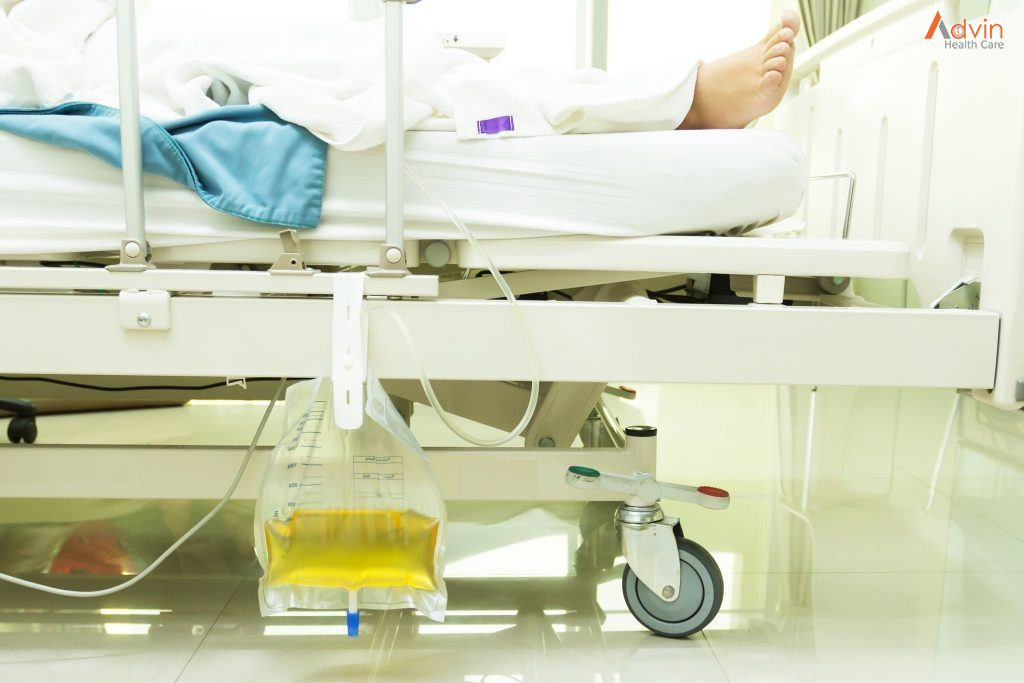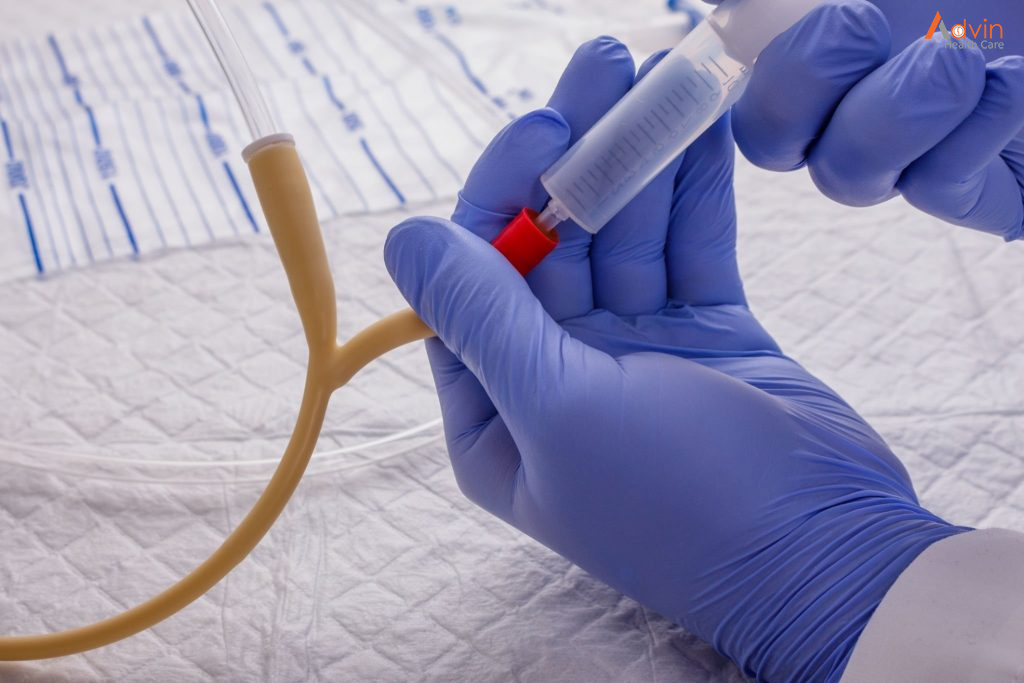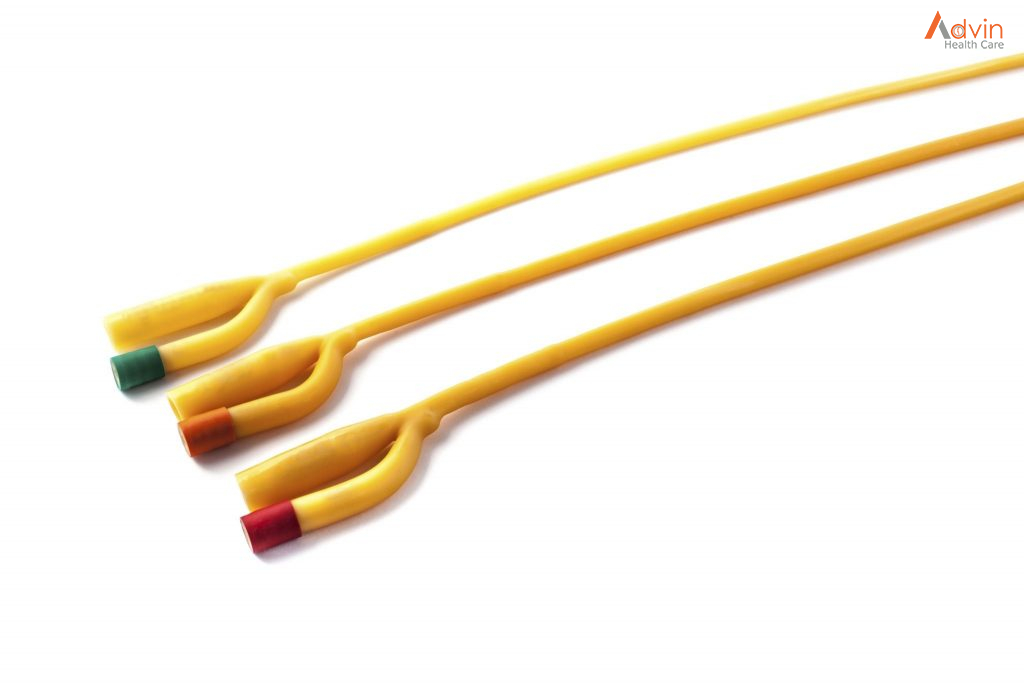You may be scheduled for a major surgery, having difficulty emptying your bladder, or experiencing urinary incontinence causing bladder leakage, and your doctor references the use of a Foley catheter. You may start asking yourself questions such as: What is a Foley catheter? Why would I need a Foley catheter? Where would I purchase a Foley catheter? We will discuss exactly what this type of catheter is, why it is used, and some things to expect if you ever need to use one. We will also provide a handy Foley catheter sizes chart for reference when you need to reorder.
What is a Foley Catheter?
Named after Frederic Foley, an American urologist, the Foley catheter design was created to provide continuous drainage of the bladder. A balloon filled with sterile water is incorporated near the tip of the catheter tubing and once inserted through the urethra and inflated, this balloon prevents the catheter from sliding out of the bladder or moving out of place.
The Foley catheter is often referred to as an indwelling catheter. As this term suggests, it is inserted into the bladder and intended to remain there for either a short or prolonged period of time, depending on the circumstance. The main purpose of the Foley catheter is to drain urine from the bladder into a collection device, typically a leg bag or drain bag.
If you are in a hospital, the collection or drainage bag will typically be emptied and changed by a nurse. Sometimes it will be next to the bed or hung on the rail of the bed for easy access. Should you be discharged from the hospital and need to administer insertion and removal of the Foley catheter yourself, a portable leg or drainage bag will be used that easily attaches to the thigh or calf with a device such as the Foley Stabilization Device.
When is a Foley Catheter Needed?

Some scenarios when the use of a Foley catheter might be necessary are:
- A major surgical procedure involving anesthesia where the patient will be unaware of the need to urinate.
- A patient in recovery that may be too weak or sick to safely make it to the restroom to urinate on their own.
- A chronic condition such as urinary incontinence where they are unable to control bladder leakage.
- Spinal trauma which may cause bladder dysfunction due to nerve-related damage.
Foley Catheter Sizes
Foley catheters are measured in terms of French units (Fr.) and range in size from 8Fr. to 26Fr. in diameter. Each Fr. unit is equal to 0.33mm (0.013″ or 1/77″) in diameter. Determining the proper French size of the indwelling catheter will depend upon the age of the person the Foley catheter will be inserted into. A child, for instance, will require the use of a smaller Fr. size Foley catheter due to their anatomy being much smaller than that of a grown adult.
It is also common for the Fr. size to increase when a person uses an indwelling catheter often and for extended periods of time. Another reason a larger Fr. size is used is for adequate drainage due to blood clots if there is blood in the patient’s urine. Great precaution should be taken when choosing the proper Foley catheter size, as one that is too large will risk damage to the urethra and cause pain and trauma to the urethral tissue. On the other hand, choosing a Foley catheter that is too small will result in potential leakage and kinking.
Different sizes of the Foley catheters are identified by color-coded ports at the balloon inflation site for easy identification. As previously mentioned, all catheters require a physician’s prescription so the correct size of the Foley catheter that is right for you will be determined by them. This Foley catheter sizes chart shows the corresponding colors and their individual French sizes.
How to Insert a Foley Catheter

Prior to insertion of a Foley catheter, the skin is cleansed with mild soap and water at and around the urethral site of entry to ensure good hygiene. The indwelling catheter is then inserted by gently pushing the catheter insertion tip up through the urethra and guiding it into the bladder. Once the tube is fully in the bladder, the balloon is gradually inflated with a syringe containing sterile saline to the recommended volume marked on the balloon port of the catheter. The indwelling catheter will then remain in place for an extended period of time. The two eyelets at the end of the Foley catheter tube allow urine to flow from the bladder, down the tubing, and into a collection container such as theUrine Drainage System or bag like the Leg Bag, and then emptied as needed.
How to Remove a Foley Catheter
Removal of the Foley catheter is a very quick and simple process that is usually painless. The balloon is deflated using a syringe to retract the saline solution. Once all of the saline is removed, the balloon flattens and the Foley catheter tubing is gently pulled out of the bladder and down the urethra until it is completely out of the body. Typically, this process must be done by a healthcare professional.
How Often is a Foley Catheter Changed?
Indwelling catheters stay inside the body for much longer periods of time than intermittent catheters. 4-week intervals is the typical time period between changeouts, however, each individual’s circumstances and needs determine the length of time that the Foley catheter will need to remain in the body. Hydrophilic and silicone indwelling catheters do not require changeouts as often as plain latex Foley catheters simply because the latex catheters are more prone to encrustation leading to obstruction.
Some common indications that a Foley catheter needs to be changed are:
- If there is leakage around the Foley catheter tubing, a changeout would be necessary.
- Any time a catheter remains in place for an extended period of time, the risk for infection increases. If you experience a fever, bladder spasms, cloudy urine, or blood in the urine, the Foley catheter should be changed.
- The excretion of proteins and calcium from the body promote encrustation formation, causing obstruction and the need to change the Foley catheter more frequently.
It is recommended to observe the sensitive skin in and around urethral entry site of the catheter as well as the urine that is being collected in the drainage bag. Contact your healthcare provider if you experience any of the following symptoms:
- You notice blood or blood clots in your urine.
- Your urine looks cloudy and gives off a foul smell.
- You are running a fever of 101 degrees or higher.
- You are not urinating or not as much and experiencing abdominal pains.
Always consult with your physician about any changes to your urine, skin, or if you’re experiencing pain. Preventive measures may be required so the condition does not worsen.
How to Care for Your Foley Catheter?

Indwelling catheters are intended for single-use and disposed of after each period of use. The skin and catheter tubing at the Foley catheter’s entry point should be cleaned with mild soap and water at least twice a day for general personal hygiene purposes and to reduce potential infection. It is also convenient to clean the entire system while in the shower, making sure you rinse well and gently dry. Bathing is not recommended with an indwelling catheter as the risk for infection increases.
Since the tubing will be long enough to travel down the leg and into a drainage bag, it should be securely taped or strapped to the leg or another tube holder of choice, to help it stay securely in place. When the catheter pulls or moves, there is a risk for pain and bladder spasms.
The Foley catheter’s drainage bag should always be placed below the waistline to prevent the backflow of urine returning the bladder. Since the Foley catheter will always be attached to the drainage bag, it is considered a closed system. The catheter drainage bag should remain fully connected to the Foley catheter tubing at all times until a bag changout is needed, typically twice a day; once in the morning to switch to the leg bag and once in the evening to changeover to the night bag.
Each time the catheter drainage bag is changed, the end of the catheter and the connector on the new drainage bag need to be wiped with alcohol prep wipes. The video below may be helpful to show you these steps.



